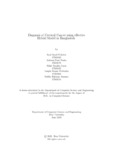| dc.contributor.advisor | Islam, Md. Saiful | |
| dc.contributor.author | Saad-Ul-Kabir, Syed | |
| dc.contributor.author | Neeha, Ashwaq Noor | |
| dc.contributor.author | Ibnat, Rifah Nanjiba | |
| dc.contributor.author | Prottasha, Tanjila Haque | |
| dc.contributor.author | Ananna, Sadika Rahman | |
| dc.date.accessioned | 2021-10-07T04:15:16Z | |
| dc.date.available | 2021-10-07T04:15:16Z | |
| dc.date.copyright | 2021 | |
| dc.date.issued | 2021-06 | |
| dc.identifier.other | ID 17101363 | |
| dc.identifier.other | ID 19101679 | |
| dc.identifier.other | ID 17101422 | |
| dc.identifier.other | ID 17101514 | |
| dc.identifier.other | ID 17301193 | |
| dc.identifier.uri | http://hdl.handle.net/10361/15163 | |
| dc.description | This thesis is submitted in partial fulfillment of the requirements for the degree of Bachelor of Science in Computer Science and Engineering, 2021. | en_US |
| dc.description | Cataloged from PDF version of thesis. | |
| dc.description | Includes bibliographical references (page 29-31). | |
| dc.description.abstract | This paper discusses the various forms of restraints, regulations, struggles, and reme dies for overcoming cervical cancer challenges. It is a life-threatening disease that
affects women all over the world. The lack of adequate early treatment has been
one of the leading causes of this. As a result, early diagnosis of cervical cancer is
important. A substantial number of deaths in Bangladesh were caused by a short age of specialists for cervical screenings. In addition, hospitals in many parts of
Bangladesh do not have medical equipment for cervical screening, such as Pap smear,
colonoscopy, and biopsy. An au-dominated system can therefore be extremely valu able for quick identification and treatment if the likelihood of cervical abnormalities
is predictable. We employed hybrid machine education for this job. From Hybrid
Machine Learning, we worked with K-Nearest Neighbor, Decision Tree, Naive Bayes,
Random Forest, Support Vector Machine, Stochastic Gradient Descent, Ada- boost,
and Recurrent Neural Network to find the data classification. KNN uses architec tures for easy and accurate detection including the classification of cervical cells.
With the use of KNN, we use demographic data to determine whether or not a pa tient has an atypical cervix instead of picture data. The advantage of a decision tree
is that all potential decisions will be analyzed and each path concluded. Moreover,
we have used the Naive Bayes algorithm. It is a probabilistic machine that may
be used for a variety of classification tasks. Random forest is a supervised learning
algorithm designed to solve classification problems. It’s just a set of decision trees
whose outcomes are combined into a single final result. We have also used SVM in
the prediction of cervical cancer. RNN is a type of artificial neural network in which
nodes’ connections form a directed graph that follows a temporal series. It can now
show temporal hierarchical actions as a result of this. We have applied for RNN
and got a good result. In each iteration, Ada-boosts are used to set the classifier
weights and to train the data sample so that those odd observations are predicted
accurately. Thanks to a unique training example processed by the network, SGD is
easy to match to memory. It is quick as only one sample is analyzed simultaneously.
These models and methods have achieved higher accuracy of the decisions that they
recommend including deep understanding to make decision-makers easier to imple ment. We got better accuracy by learning implicit, non-implicit, and non-symbolic knowledge. Furthermore, in the future, we will use more algorithms to improve
accuracy. | en_US |
| dc.description.statementofresponsibility | Syed Saad-Ul-Kabir | |
| dc.description.statementofresponsibility | Ashwaq Noor Neeha | |
| dc.description.statementofresponsibility | Rifah Nanjiba Ibnat | |
| dc.description.statementofresponsibility | Sadika Rahman Ananna | |
| dc.description.statementofresponsibility | Tanjila Haque Prottasha | |
| dc.format.extent | 31 Pages | |
| dc.language.iso | en | en_US |
| dc.publisher | Brac University | en_US |
| dc.rights | Brac University theses are protected by copyright. They may be viewed from this source for any purpose, but reproduction or distribution in any format is prohibited without written permission. | |
| dc.subject | Cervical Cancer | en_US |
| dc.subject | K-Nearest Neighbor | en_US |
| dc.subject | Hybrid Machine Learning | en_US |
| dc.subject | Demography | en_US |
| dc.subject | Stochastic Gradient Descent | en_US |
| dc.subject | Recurrent Neural Network | en_US |
| dc.subject | Support Vector Machine | en_US |
| dc.subject | Random Forest | en_US |
| dc.subject | Naive Bayes | en_US |
| dc.subject | AdaBoost | en_US |
| dc.subject.lcsh | Cervical cancer | |
| dc.title | Diagnosis of cervical cancer using effective hybrid model in Bangladesh | en_US |
| dc.type | Thesis | en_US |
| dc.contributor.department | Department of Computer Science and Engineering, Brac University | |
| dc.description.degree | B. Computer Science | |

